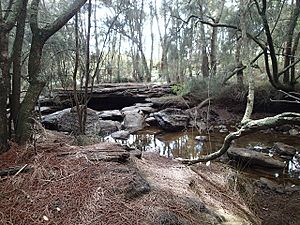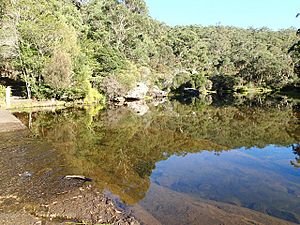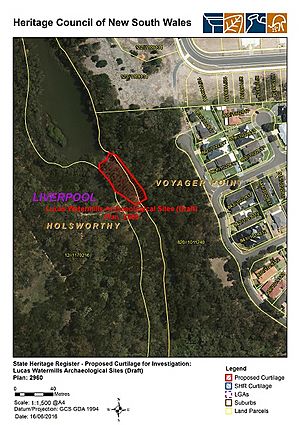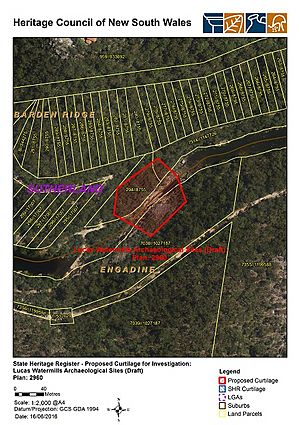Lucas Watermills Archaeological Sites facts for kids
Quick facts for kids Lucas Watermills Archaeological Sites |
|
|---|---|
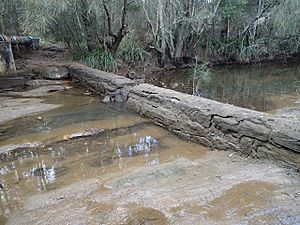
Brisbane Mill archaeological site
|
|
| Location | Creekwood Reserve, Voyager Point, City of Liverpool, Sydney New South Wales, Australia |
| Built | 1822–1825 |
| Architect | John Lucas |
| Official name: Lucas Watermills Archaeological Sites; The Brisbane Mill; The Woronora Mill | |
| Type | state heritage (archaeological-maritime) |
| Designated | 30 August 2017 |
| Reference no. | 1989 |
| Type | Other - Maritime Industry |
| Category | Maritime Industry |
| Builders | Convict labour |
| Lua error in Module:Location_map at line 420: attempt to index field 'wikibase' (a nil value). | |
The Lucas Watermills Archaeological Sites are two important historical places in Sydney, New South Wales, Australia. These sites hold the remains of two watermills from the early days of the colony. They are called the Brisbane Mill and the Woronora Mill.
The Brisbane Mill is located on Williams Creek in Voyager Point. The Woronora Mill is on the Woronora River near Barden Ridge. John Lucas designed these mills. They were built between 1822 and 1825 by assigned convicts. These sites were added to the New South Wales State Heritage Register on 30 August 2017.
History of Milling in New South Wales
Early Challenges with Food Production
When the first European settlers arrived in New South Wales, growing food was very hard. They tried to use farming methods from Europe. But these methods and crops did not always work well in Australia's climate.
Growing wheat was difficult due to the weather and plant diseases. Turning grain into flour was also a big problem. The colonists did not have enough skilled workers or the right tools.
First Mills in the Colony
There were not many experienced mill builders in the early colony. The First Fleet brought four millstones, but no one knew how to build a proper mill. At first, people used small hand mills. These mills were slow and wore out quickly.
In 1791, Governor Phillip said a windmill was urgently needed. But building one was expensive and took too much effort. In 1793, a convict named Wilkinson built a treadmill. Two men walking on it could grind only one bushel of grain per hour.
Later, horses and bullocks were used to power mills. In 1797, the first successful windmill was built at Millers Point in Sydney. But milling was still slow. Many problems like storms, theft, and a lack of skilled workers made things harder.
Nathaniel Lucas, a Skilled Builder
The first watermill and windmill in the colony were built on Norfolk Island in 1794. This happened under the direction of Lieutenant-Governor King. He had help from Nathaniel Lucas, a convict who was a very skilled carpenter. Nathaniel Lucas knew how to build mills.
When King became Governor of New South Wales, he found it was still hard to build mills in Sydney. There were not enough skilled workers or good building materials. Nathaniel Lucas helped by building more mills. He also taught his son, John, about building and milling.
Watermills and Steam Mills
Building watermills was especially hard in Australia. The amount of rain changed a lot, so rivers did not always flow steadily. Early attempts to build watermills failed because of this. But over time, people learned more about the local conditions.
In the 1860s, the number of mills in the Sydney area started to decrease. This was because less grain was grown there. New farming lands opened up in other areas. Later, trains made it cheaper to transport goods. This led to most milling being done in big cities.
Steam power was developed in England. The first steam mill in Australia was built in Sydney in 1815. By the 1850s, steam mills became the most common type of mill.
Nathaniel Lucas's Life
Nathaniel Lucas was a builder, joiner, and carpenter. He came to Sydney as a convict with the First Fleet. He was one of 15 convicts chosen to go to Norfolk Island in 1788.
He married Olivia Gascoine, another convict. They had 13 children. In 1795, Nathaniel became the master carpenter on Norfolk Island. He built many buildings there. He also built an important watermill in 1795. This was the first successful mill of its kind in the colony.
In 1805, Nathaniel returned to Sydney. He became the Superintendent of Carpenters. He brought parts for two windmills from Norfolk Island. He built these mills in Sydney. One was near what is now the Sydney Observatory. Nathaniel is known for building six mills in total. He taught his son, John, the building and mill-making trades.
Nathaniel also had other businesses. He built and sold boats. He even built a large schooner called Olivia. This boat was used by the Lucas family to ship goods until the late 1820s.
In 1818, Nathaniel got the job to build St Luke's Church in Liverpool. The architect was Francis Greenway. Nathaniel Lucas died in 1818. His body was found in the Georges River.
John Lucas's Story
John Lucas was born on Norfolk Island in 1796. His parents, Nathaniel and Olivia, were both convicts from the First Fleet. John moved to Sydney when he was nine. He followed his father's path, learning carpentry and milling. He also started many businesses.
John built and ran three mills. He also owned an inn called "The Black Swan" in George Street, Sydney. He had a warehouse in Liverpool. In 1817, John married Mary Rowley. They had 10 children.
John faced many challenges with his businesses. His first watermill, the Brisbane Mill, was built in 1822. It suffered from droughts and floods. To make up for losses, John built another mill, the Woronora Mill, in a remote area on the Woronora River.
The location of his mills on the Georges River might have helped John avoid paying taxes on his flour. He could ship it in small boats to Liverpool. Then he could transport it by land to Sydney markets.
But John faced many problems. His family's ship, the Olivia, sank in 1827. His brother and business partner, William, died. Also, steam mills were becoming more popular. Because of all these issues, John was declared bankrupt in 1828. His two mills were given to his creditors.
John later recovered from his financial problems. This was mostly thanks to money his wife inherited in 1832. He became a big landowner in the Burwood area. He died in 1875.
The suburb of Lucas Heights is named after John Lucas. Many other places and streets in NSW also carry his name.
John and Mary's oldest son, also named John Lucas, became a politician. He was a builder and carpenter. He worked to create free state schools and protect areas like Jenolan Caves. One of the largest caves there is named after him.
Building the Brisbane Mill
John Lucas built the Brisbane Mill in 1822. It was on Harris Creek, which is now called Williams Creek. He built it on land that was better suited for a mill, even though it was not his own. The mill was named after Governor Sir Thomas Brisbane, who had given the land to John.
The area was quite remote. It was called Liverpool because it was near that town. It was hard to get to by land. The area was good for farming. John and Mary Lucas lived at the Brisbane Mill with their five children and nine assigned convicts. They also had other buildings, crops, and animals there.
The Brisbane Mill was not just for milling flour. It was also a shop. An advertisement from 1824 showed that it sold many goods. These included tea, sugar, soap, clothes, tools, and drinks. This shows that John Lucas tried to run many businesses from the site.
John faced financial difficulties. He could not pay for his millstones when the mill was built. He also struggled with the changing price of wheat. A big flood destroyed his mill and dam in late 1824. This made him look for a second mill site.
Building the Woronora Mill
John Lucas built his second mill on the Woronora River in 1825. Like the Brisbane Mill, he built it on land that was best for the mill, even if it was not his own. This area was very remote.
The mill wheel and machinery were likely made elsewhere. Then they were taken apart and brought by boat to the mill site. Moving these large parts and the heavy millstones would have needed many workers.
Once built, a small group of workers would operate the mill. Some trees were cleared to build small homes. They might have also kept some animals and grown crops.
Financial Troubles and What Happened Next
In 1828, John Lucas was declared bankrupt. This meant he could not pay his debts. His two mills were given to his creditors.
Later, the Brisbane Mill was transferred to Solomon Levey, and then to his business partner Daniel Cooper. The Brisbane Mill continued to operate for some time. It was also used as a shop. Later, other types of mills, like a paper mill and a wool wash, were built on the same site. This shows how milling technology changed over time.
The Woronora Mill never operated again after John Lucas lost it. An advertisement from 1843 said the Woronora Mill had "burnt down some years ago." The remote area around the Woronora Mill later attracted people who built huts there. These were used as weekend homes but were destroyed by bushfires.
The Dharawal People
The Dharawal people are the original owners of the land where these mills are located. Their land stretches from Botany Bay to the Shoalhaven River. For thousands of years, they used the natural resources of the land. The Georges River and its smaller streams provided water, food, and shelter.
They found food like possums, lizards, kangaroos, and wallabies in the forests. They also gathered roots, berries, and seeds. Birds provided meat and eggs. Along the Georges River, there are rock overhangs that gave shelter. The walls of these shelters often have ancient art. This art includes images and hand stencils made with red ochre, white clay, or charcoal.
Evidence of their paths, camps, and important sites can still be found today. These places are still meaningful to the Dharawal people.
When European settlers expanded into Dharawal country, there were conflicts. However, some Europeans formed good relationships with the local Aboriginal community. Some, like Hamilton Hume, knew that Aboriginal people's knowledge of the land was very helpful in this new environment.
There are no records of John Lucas's interactions with Aboriginal people. But it is likely he would have met them often.
Description of the Sites
The Lucas Watermills are found at two separate historical sites in south-west Sydney. These sites contain the remains of the Brisbane Mill and the Woronora Mill. They also include parts of their dams, machinery, and buildings.
The Brisbane Mill
This site is in a wet, tidal area on Williams Creek. The area around it has trees and mangroves. There is a public path from Creekwood Reserve to the site. Many smaller paths run through the site. Small boats can travel on the creek up to about 10 meters below the dam.
At the northern end of the site, there are marks on rocks where Aboriginal people sharpened their axes. This shows that the Dharawal people used this place.
You can see different types of old industrial remains here. There is a large channel cut into the rock. Other rock work shows marks from picks, meaning they were built in the early 1800s. You can also see parts of two dams made of rock and cement.
The remains suggest the mill was on the western side of the creek.
Here are four things you can see:
- Cuts in the bedrock, made with rock picks. These are very common.
- Holes drilled into the rock, about 50mm wide.
- Walls of stone and cement dams. Some parts are from Lucas's mill (1825). Other parts are from later paper and wool mills that used the site.
- A long, narrow trench cut through rock. It is about 12 meters long and 1 meter wide. This was likely the mill race, which carried water to the mill wheel.
The Woronora Mill
This site is on the Woronora River. It is in a steep valley with rocky, open woodland. You can walk to it using a fire trail. A large water supply pipe runs above the site on the southern side of the river. Small boats can travel on the river up to about 60 meters west of the site. The remains suggest the mill was on a flat rock shelf on the north-eastern side of the river.
Here are three things you can see:
- Cuts in the bedrock, made with rock picks. The largest cuts could hold a timber beam about 450mm wide. This would have supported the water wheel.
- Holes drilled into the rock, about 50mm wide.
- Leftover cement that shows where the mill dam used to be.
Condition of the Sites
At the Brisbane Mill site, many materials were likely reused or removed by people who lived there later, up until the 1920s.
Fires and floods have destroyed most of the Woronora Mill's structure since it was abandoned. However, archaeological digs might still find parts of the structures that controlled water flow, the waterwheel, mill machinery, and other buildings.
Heritage Listing
The Lucas Watermills Archaeological Sites are very important historically. They were built by John Lucas, a well-known miller from the colonial period. These are two of the oldest surviving watermill sites in New South Wales. They are also linked to John's father, Nathaniel Lucas, who was a First Fleet Convict. Nathaniel built six of the first mills in the colony. This makes the sites important for the whole state.
Convict labor was used to build these mills. The sites show how John Lucas tried to change his milling plans to deal with environmental problems. They show how hard it was to produce food, especially flour, in the new colony. They also show the early development of the milling industry and how goods were transported. The story of Lucas's watermills also tells us about the business dreams of people in New South Wales in the 1820s.
The Lucas Watermills Archaeological Sites were added to the New South Wales State Heritage Register on 30 August 2017. They met the following important reasons:
The place shows important parts of New South Wales's history.
- Lucas's Mills are historically important as two of the earliest industrial archaeological sites in the state.
- The mills and their machinery were built and operated using convict labor.
- These sites show how early business owners used the fertile lands along the Georges River for transport and trade in the 1820s. This connected the area closely with Liverpool, Botany Bay, and Sydney.
- The locations Lucas chose for his mills are important. They tell the story of early attempts by the government to control flour production and how the industry reacted.
- The way Lucas changed his machinery and facilities at both sites shows how hard it was to produce food in the new colony. It was difficult to adapt technology to the new environment and find skilled workers.
The place is strongly connected to important people or groups in New South Wales's history.
- The mills are connected to their builder, the important miller John Lucas. They are also linked to his father, Nathaniel Lucas.
- Nathaniel Lucas (1764–1818) was a convict who came on the First Fleet. He was a Master Carpenter and built six of the first successful mills in the colony. He also worked on major building projects. He taught his sons his trade.
- The sites are also connected to later owners, Solomon Levey and Daniel Cooper. They were very successful business owners in the early colony. They also had interests in the milling industry.
- The Brisbane Mill was named after Governor Sir Thomas Brisbane (1773–1860). He gave the land to Lucas.
The place shows special beauty or great creative or technical skill in New South Wales.
- The two mills and the waterways connecting them help us understand the maritime landscape of the 1820s.
- They show the early development of the milling industry. They also show the transport networks that supplied the mills and distributed their products.
- You can see remains like cuts in the bedrock, drilled holes, and stone and cement dam walls. These show where the mill dams, wheel pits, and channels were. They also show how people learned to use water better over time.
The place has the potential to give us information that helps us understand New South Wales's history.
- Archaeological digs at the site might find parts of structures that controlled water flow, mill machinery, and other buildings.
- The sites and how they relate to each other offer a special chance to understand how milling and food production developed in the early colony.
- The Brisbane Mill site was used for paper and wool industries later on (from the 1870s to the 1920s). New dams and a steam mill were built. This shows how milling technology changed over a century.
The place has rare or endangered aspects of New South Wales's history.
- There are other old watermills in the state. But these are some of the earliest. They are also the only major remains in the Sydney area that have not been disturbed much.
The place shows the main features of a type of historical place or environment in New South Wales.
- Lucas's sites and how they changed are good examples of early milling structures in NSW. Building them needed a lot of testing to deal with local environment and transport problems. Many of these early attempts were not successful in the long run.


